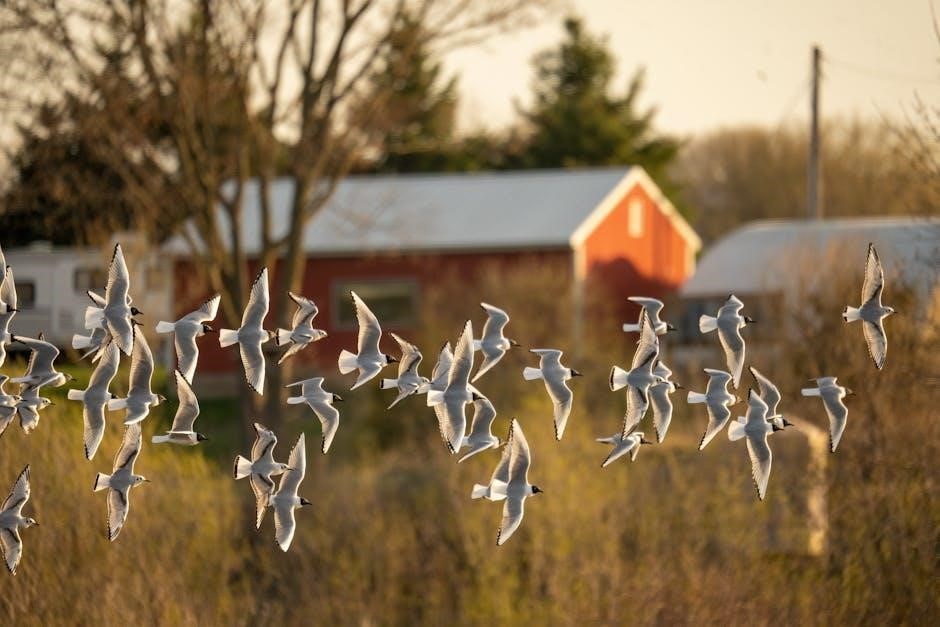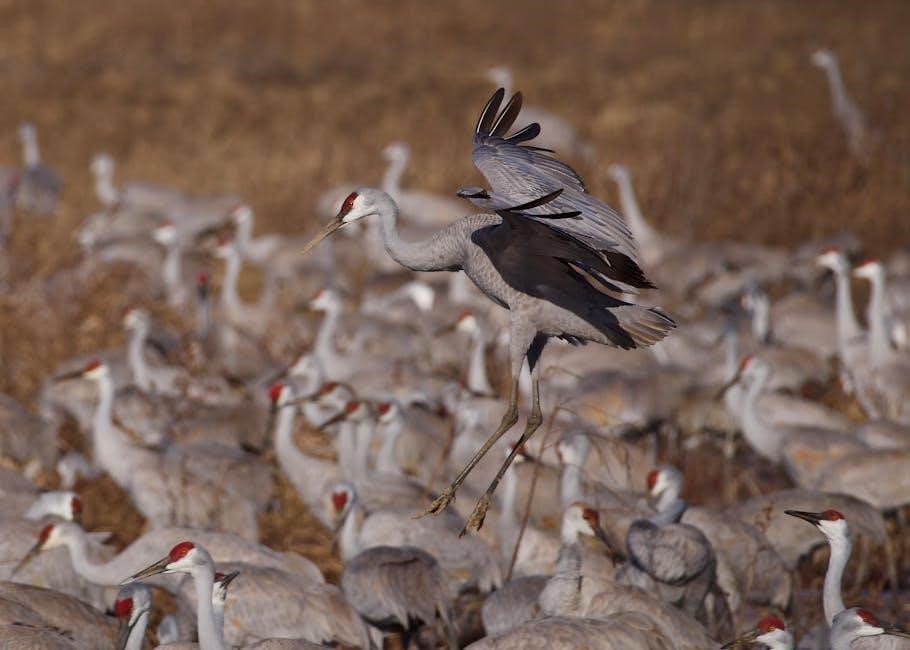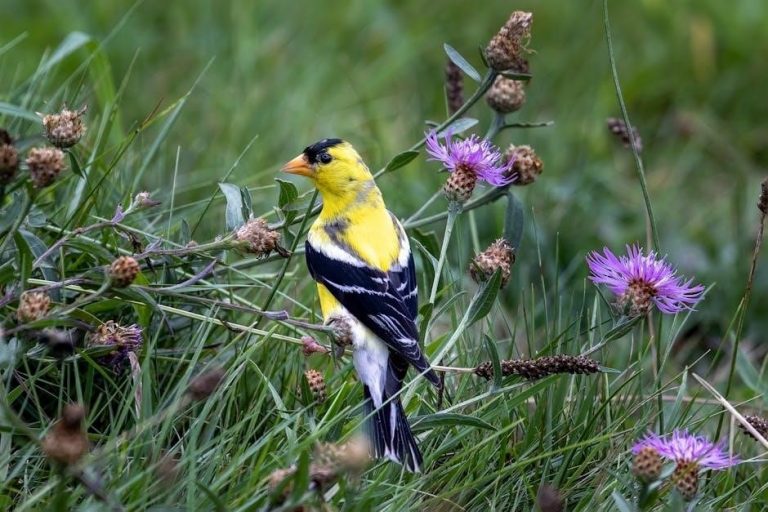Welcome to the Field Guide to Birds of North America, your essential companion for exploring the continent’s diverse bird species. This guide provides detailed insights, vibrant descriptions, and expert tips to enhance your birdwatching adventures, ensuring a deeper connection with nature and its feathered wonders.
What is a Field Guide?
A field guide is a comprehensive resource designed to help identify and understand species in their natural habitats. For birdwatching, it typically includes detailed descriptions, high-quality illustrations, and maps. These guides organize information by species, habitat, or region, making it easier to locate and recognize birds. They often feature visual cues like plumage, size, and behavior, alongside tips for distinguishing similar species. A well-structured field guide is indispensable for both novice and experienced birders, enhancing the overall birdwatching experience by providing quick access to essential information.
Importance of Field Guides for Birdwatching
Importance of Field Guides for Birdwatching
Field guides are indispensable tools for birdwatching, offering essential insights for identifying species, understanding habitats, and recognizing behaviors. They provide quick access to detailed information, enabling birders to make accurate identifications in the field. These guides also serve as educational resources, helping learners develop observation skills and deepen their knowledge of ornithology. By documenting sightings and tracking seasonal patterns, field guides enhance the overall birding experience, making them a vital companion for enthusiasts of all levels while supporting conservation efforts and fostering a greater appreciation for avian diversity.

Key Characteristics of a Great Bird Field Guide
A great bird field guide features high-quality images, detailed descriptions, and an organized layout for easy navigation, ensuring quick and accurate species identification in the field.
High-Quality Illustrations and Photos
High-quality illustrations and photos are essential for accurate bird identification. They provide clear depictions of plumage, size, and shape, helping birders distinguish between similar species. Detailed images showcasing various plumage stages, such as breeding and non-breeding colors, are particularly useful. Photographs in natural habitats add context, while comparative illustrations highlight key field marks. These visuals, often accompanied by labels, ensure that birders can quickly identify species, making them indispensable for both beginners and experienced birdwatchers.
Organized and Easy-to-Use Format
A well-organized field guide is crucial for efficient bird identification. Typically arranged by taxonomic order, it groups similar species together, making comparisons easier. Clear headings, concise descriptions, and quick reference icons simplify navigation; Range maps and habitat notes are often placed alongside species accounts, providing essential context. This logical structure ensures that birders can swiftly locate and compare information, enhancing their ability to identify birds accurately in the field.

How to Identify Birds Using a Field Guide
Identifying birds begins with observing key features like plumage, size, and shape. Use clear descriptions and range maps in your guide to match sightings with species accurately.
Visual Identification: Plumage, Size, and Shape
Visual identification relies on key bird characteristics: plumage patterns, size, and shape. Field guides provide detailed illustrations and descriptions to help distinguish species. Pay attention to distinctive markings, color variations, and body proportions. Comparing birds in the guide ensures accurate identification, especially for similar species. This method allows birders to quickly confirm sightings and expand their knowledge of North America’s diverse avifauna, making every observation more rewarding and precise.
Behavioral Clues: Habitat, Flight Patterns, and Feeding Habits
Behavioral clues are crucial for identifying birds. Field guides detail habitat preferences, flight patterns, and feeding behaviors, helping birders recognize species. Observing where a bird forages, how it flies, and what it eats provides insights into its identity. For example, a bird flitting between shrubs may be a warbler, while one soaring overhead could be a raptor. These observations, combined with visual cues, enhance accurate identification and deepen understanding of bird ecology, making birdwatching more engaging and effective.
Bird Habitats and Distribution in North America
North America’s diverse ecosystems, from forests to wetlands, support a wide variety of bird species. Understanding their habitats and seasonal distribution patterns is key to effective birdwatching and conservation efforts.
Major Birding Regions and Their Unique Species
North America boasts diverse birding regions, each hosting unique species. The Gulf Coast is a critical stopover for migratory birds like the Ruby-throated Hummingbird and Yellow Warbler. The Pacific Northwest is home to the Great Gray Owl and Marbled Murrelet, while the Great Lakes region attracts waterfowl such as the Common Loon and Red-breasted Merganser. These areas’ varied habitats, from wetlands to forests, support a wide range of avifauna, making them essential destinations for bird enthusiasts.
Seasonal Migration Patterns
North America’s birds exhibit remarkable seasonal migration patterns, with species traveling between breeding and wintering grounds. Major flyways like the Pacific, Central, Mississippi, and Atlantic routes guide these journeys. Many songbirds, such as warblers and tanagers, migrate to Central or South America, while waterfowl and shorebirds move between northern breeding areas and southern wintering grounds. These migrations occur twice annually, driven by weather changes and daylight shifts. Key stopover sites provide crucial rest and refueling stops. Understanding these patterns is vital for birders seeking to maximize sightings and appreciate the continent’s avifauna.
Advanced Bird Identification Techniques
Advanced bird identification techniques involve detailed plumage analysis, behavioral observations, and recognizing bird calls. Using apps and field guides enhances accuracy, especially for rare or similar species.
The Role of Bird Calls and Songs
Bird calls and songs are vital for identification, especially for species that are difficult to observe. Listening to these vocalizations helps distinguish between similar birds and enhances your birding experience. By familiarizing yourself with recordings in field guides or apps, you can recognize patterns and unique traits. This skill is particularly useful in dense habitats where birds may remain hidden. Learning to identify calls requires practice but significantly improves your ability to detect and catalog species accurately during your birdwatching adventures.
Using Technology: Apps and Online Tools for Birders
Modern birding is enhanced by technology, with apps like Merlin Bird ID and iBird Pro offering visual and audio identification tools. These platforms use AI to analyze photos and sounds, aiding in accurate species recognition. eBird provides real-time sighting maps, enabling birders to track migrations and locate rare species. Online forums and citizen science projects foster community engagement, while digital field guides replace bulky books. These tools empower birders to explore, document, and contribute to conservation efforts more efficiently than ever before.

Documenting Bird Sightings
Recording bird observations helps track species distributions, monitor populations, and personalize birding experiences. Journals, apps, and platforms like eBird simplify documentation, supporting conservation and community sharing efforts effectively.
The Importance of Keeping a Birding Journal
Keeping a birding journal is a valuable practice that enhances your birdwatching experience. It allows you to record observations, track species identification, and reflect on learning over time. By noting details like plumage, behavior, and habitats, you create a personal archive of encounters, aiding in refining identification skills. Additionally, journals serve as historical records, helping conservation efforts by documenting population trends and habitat changes. This habit fosters a deeper connection to nature and supports citizen science initiatives like eBird, making your observations contribute to broader environmental understanding and protection.
Using eBird and Other Platforms for Citizen Science
Platforms like eBird and iNaturalist empower birders to contribute to citizen science. By uploading sightings, photos, and audio recordings, users support global bird conservation efforts. These tools provide real-time data on species distribution, migration patterns, and population trends, aiding researchers and policymakers. They also offer personalized tracking, enabling birders to monitor their life lists and explore habitats. Such platforms foster community engagement, education, and collaboration, making birdwatching a collective effort to protect avian diversity and ecosystems worldwide.

Conservation and Ethical Birdwatching
Birdwatching promotes environmental stewardship by raising awareness of species conservation. Ethical practices, such as minimizing habitat disturbance and supporting eco-friendly tourism, help protect birds and their ecosystems.
Responsible Birding Practices
Responsible birding involves minimizing habitat disturbance and avoiding disruptive behaviors. Keep a safe distance from birds, especially during nesting seasons, to prevent stress. Refrain from using flash photography or playback of bird calls, as these can disrupt natural behaviors. Always follow local regulations and respect private property. Be mindful of sensitive habitats and avoid littering or damaging vegetation. By adopting these practices, birders can help protect bird populations and preserve their ecosystems for future generations while enjoying their birdwatching experiences responsibly.
Protecting Bird Habitats and Populations
Conserving bird habitats is crucial for maintaining healthy populations. Protecting wetlands, forests, and grasslands ensures birds have safe breeding and feeding grounds. Reducing pesticide use and promoting sustainable land practices also safeguard ecosystems. Addressing climate change and deforestation is vital, as these threats disrupt habitats and migration patterns. Supporting conservation organizations and participating in citizen science initiatives can make a significant impact. By prioritizing habitat preservation, birders contribute to the long-term survival of North America’s avifauna and the biodiversity they support.
Your journey through the Field Guide to Birds of North America concludes here, but the adventure continues. Armed with knowledge, explore, appreciate, and protect the avian wonders of the continent, fostering a lifelong connection with nature and its incredible diversity.
Maximizing Your Birding Experience with a Field Guide
A field guide is more than a reference; it’s a gateway to enriching your birding adventures. By combining detailed descriptions, high-quality illustrations, and organized formats, it helps you quickly identify species, understand habitats, and recognize behaviors. Use it to note observations, track seasonal changes, and explore regional variations. Pairing it with apps and online tools enhances your experience, ensuring you make the most of every outing and deepen your connection with North America’s avian diversity.
Encouraging Others to Explore Birdwatching
Sharing the joy of birdwatching with others can inspire a new generation of nature enthusiasts. Use your field guide to teach friends and family how to identify species, fostering curiosity and appreciation for wildlife. Start with local birding hotspots and emphasize the importance of conservation. By making the experience interactive and enjoyable, you can help others connect with nature, creating lasting memories and a shared passion for birding.
